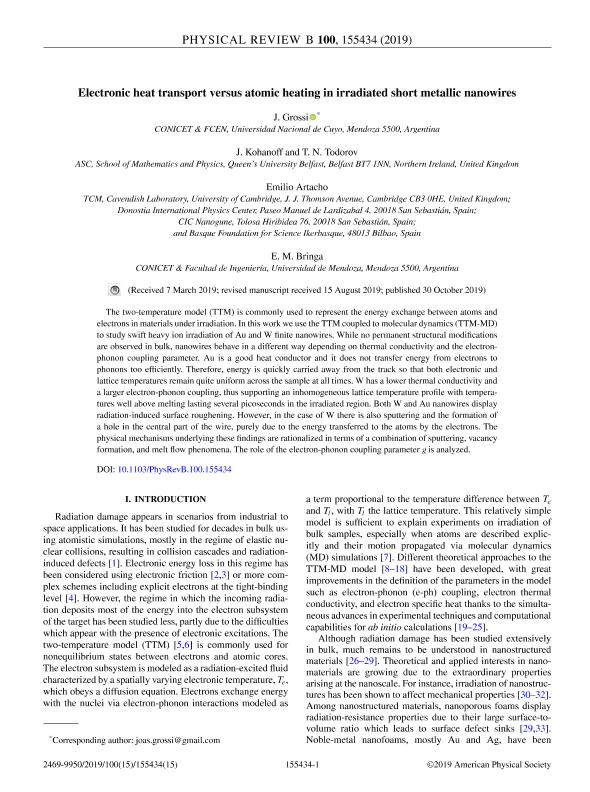Mostrar el registro sencillo del ítem
dc.contributor.author
Grossi, Joás Santiago

dc.contributor.author
Kohanoff, Jorge Jose

dc.contributor.author
Todorov, T. N.
dc.contributor.author
Artacho, Emilio
dc.contributor.author
Bringa, Eduardo Marcial

dc.date.available
2022-05-13T12:34:56Z
dc.date.issued
2019-10
dc.identifier.citation
Grossi, Joás Santiago; Kohanoff, Jorge Jose; Todorov, T. N.; Artacho, Emilio; Bringa, Eduardo Marcial; Electronic heat transport versus atomic heating in irradiated short metallic nanowires; American Physical Society; Physical Review B; 100; 15; 10-2019; 1-15
dc.identifier.issn
2469-9950
dc.identifier.uri
http://hdl.handle.net/11336/157458
dc.description.abstract
The twoerature model (TTM) is commonly used to represent the energy exchange between atoms and electrons in materials under irradiation. In this work we use the TTM coupled to molecular dynamics (TTM-MD) to study swift heavy ion irradiation of Au and W finite nanowires. While no permanent structural modifications are observed in bulk, nanowires behave in a different way depending on thermal conductivity and the electron-phonon coupling parameter. Au is a good heat conductor and it does not transfer energy from electrons to phonons too efficiently. Therefore, energy is quickly carried away from the track so that both electronic and lattice temperatures remain quite uniform across the sample at all times. W has a lower thermal conductivity and a larger electron-phonon coupling, thus supporting an inhomogeneous lattice temperature profile with temperatures well above melting lasting several picoseconds in the irradiated region. Both W and Au nanowires display radiation-induced surface roughening. However, in the case of W there is also sputtering and the formation of a hole in the central part of the wire, purely due to the energy transferred to the atoms by the electrons. The physical mechanisms underlying these findings are rationalized in terms of a combination of sputtering, vacancy formation, and melt flow phenomena. The role of the electron-phonon coupling parameter g is analyzed.
dc.format
application/pdf
dc.language.iso
eng
dc.publisher
American Physical Society

dc.rights
info:eu-repo/semantics/openAccess
dc.rights.uri
https://creativecommons.org/licenses/by-nc-sa/2.5/ar/
dc.subject
NANOWIRES
dc.subject
ION IRRADIATION
dc.subject
DEFECTS
dc.subject.classification
Nano-materiales

dc.subject.classification
Nanotecnología

dc.subject.classification
INGENIERÍAS Y TECNOLOGÍAS

dc.title
Electronic heat transport versus atomic heating in irradiated short metallic nanowires
dc.type
info:eu-repo/semantics/article
dc.type
info:ar-repo/semantics/artículo
dc.type
info:eu-repo/semantics/publishedVersion
dc.date.updated
2022-05-06T16:30:43Z
dc.identifier.eissn
2469-9969
dc.journal.volume
100
dc.journal.number
15
dc.journal.pagination
1-15
dc.journal.pais
Estados Unidos

dc.description.fil
Fil: Grossi, Joás Santiago. Consejo Nacional de Investigaciones Científicas y Técnicas. Centro Científico Tecnológico Conicet - Mendoza; Argentina. Universidad Nacional de Cuyo; Argentina
dc.description.fil
Fil: Kohanoff, Jorge Jose. The Queens University of Belfast; Irlanda
dc.description.fil
Fil: Todorov, T. N.. The Queens University of Belfast; Irlanda
dc.description.fil
Fil: Artacho, Emilio. University of Cambridge; Estados Unidos
dc.description.fil
Fil: Bringa, Eduardo Marcial. Universidad de Mendoza; Argentina. Consejo Nacional de Investigaciones Científicas y Técnicas. Centro Científico Tecnológico Conicet - Mendoza; Argentina
dc.journal.title
Physical Review B
dc.relation.alternativeid
info:eu-repo/semantics/altIdentifier/doi/http://dx.doi.org/10.1103/PhysRevB.100.155434
dc.relation.alternativeid
info:eu-repo/semantics/altIdentifier/url/https://journals.aps.org/prb/abstract/10.1103/PhysRevB.100.155434
Archivos asociados
